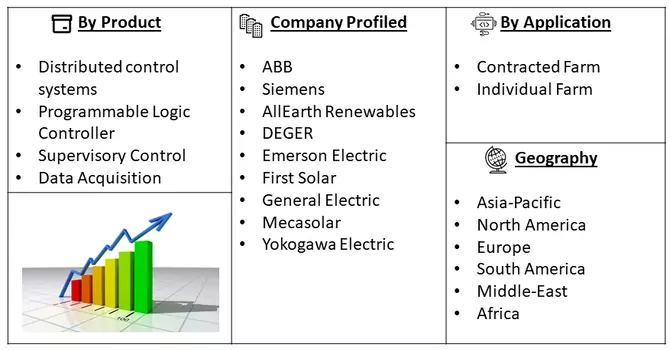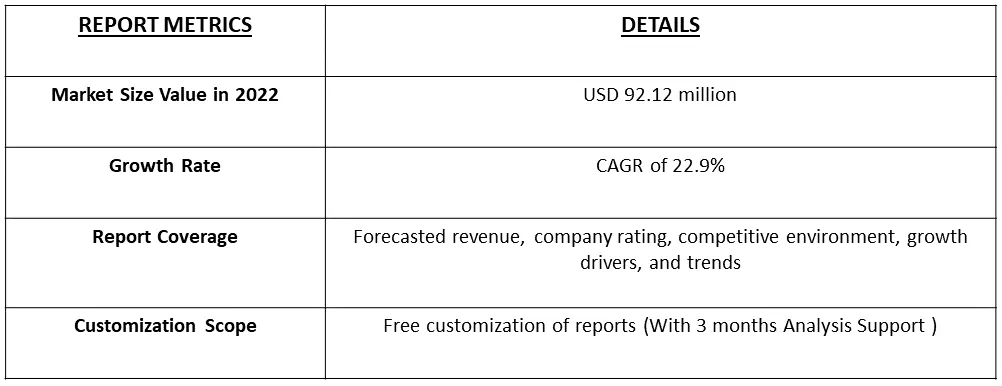The global solar farm automation market size was valued at USD 92.12 million in 2022, and is expected to register a CAGR of 22.9% over the forecast period, 2023-2030.

Get Complete Analysis Of The Report - Download Free Sample PDF
The "solar farm automation market" refers to the segment of the renewable energy industry that focuses on the development and deployment of automation technologies to enhance the efficiency, reliability, and performance of solar farms or solar power plants. Solar farm automation involves the integration of various technologies, including sensors, monitoring systems, data analytics, artificial intelligence, and control mechanisms, to optimize the operation of solar power facilities.
Solar farm automation solutions are scalable, allowing operators to expand their solar farms easily. This scalability accommodates the growth of solar power generation capacity. Automation systems enhance the reliability of solar farms by providing real-time monitoring, predictive maintenance, and rapid issue detection. This results in reduced downtime and more consistent energy production.
Solar farms are increasingly incorporating single-axis and dual-axis tracking systems to maximize energy capture by orienting solar panels towards the sun. These tracking systems are becoming a standard feature in modern solar farm designs. The Internet of Things (IoT) is being employed for remote monitoring and control of solar farms. IoT sensors and devices enable operators to track performance, detect anomalies, and make adjustments remotely, improving operational efficiency.
Market Segmentation: The Global Solar Farm Automation Market, is Segmented By Product (Distributed control systems, Programmable Logic Controller, and Supervisory Control and Data Acquisition), By Application (Contracted Farm and Individual Farm), and by Geography (North America, Europe, Asia-pacific, South America, and Middle East and Africa). The report offers market size and forecasts for the Solar Farm Automation Market in value (USD Million) for all the above segments.

For Detailed Market Segmentation - Download Free Sample PDF
Market Drivers:
Growing Adoption of Solar Energy as a Clean and Sustainable Power Source
Solar energy has emerged as a frontrunner in the global shift towards clean and sustainable power sources. The adoption of solar energy is accelerating at a remarkable pace, and this transformation is significantly impacting the solar farm automation market. The growing adoption of solar energy is driving the need for larger and more efficient solar farms. These utility-scale installations require advanced automation solutions to optimize energy production and operational efficiency. The growing adoption of solar energy as a clean and sustainable power source is a pivotal driver in the global transition to renewable energy. This transformation is deeply intertwined with the solar farm automation market, as automation technologies enable more efficient, reliable, and environmentally responsible solar energy production. As the solar energy revolution continues to unfold, the solar farm automation market will play an indispensable role in harnessing the full potential of solar power and accelerating the transition to a greener and more sustainable energy future. Thus, the market is expected to witness significant growth over the forecast period.
Increasing Advancements in Automation Technologies, Such as Robotics, Sensors, and Data Analytics
The global solar farm automation market is undergoing a transformation, driven by remarkable advancements in automation technologies. Robotics, sensors, data analytics, and a range of cutting-edge tools are revolutionizing the way solar farms operate. Data analytics tools, powered by artificial intelligence (AI), process vast amounts of data collected from solar farms. This data is used for predictive maintenance, performance optimization, and energy forecasting. AI algorithms identify patterns and anomalies, leading to proactive issue resolution and improved energy output. The solar farm automation market is on the cusp of a technological revolution, fueled by advancements in automation technologies. Robotics, sensors, data analytics, and AI are enhancing the efficiency, reliability, and environmental responsibility of solar farms. These technologies are driving cost reduction, improving energy yields, and accelerating the transition to renewable and sustainable energy sources. As solar farms embrace these innovations, the future of solar energy production is brighter than ever. Thus, the market is expected to witness significant growth over the forecast period.
Restraints :
High Initial Investment and Complexity and Integration
The global farm automation market holds immense promise for revolutionizing agriculture, yet it faces significant barriers that hinder its growth. Two notable challenges are the high initial investment required and the complexity of integrating automation solutions into existing agricultural systems. High initial investment and the complexity of integration pose substantial challenges for the global farm automation market. However, with the right strategies and support in place, these barriers can be surmounted. Governments, industry stakeholders, and financial institutions can play pivotal roles in facilitating automation adoption by providing incentives, financing options, and standardization. Thus, the growth of the market is expected to slow down the growth of the market over the forecast period.
Segmental Analysis:
Distributed Control Systems Segment is Expected to Witness Significant growth Over the Forecast Period
Distributed Control Systems (DCS) are emerging as key enablers in the field of solar farm automation, contributing to improved efficiency, streamlined operations, and effective management. In this article, we explore the pivotal role of DCS in the solar farm automation market and how these systems are transforming the solar energy landscape. DCS automation minimizes waste, reduces resource consumption, and aligns solar energy production with environmental sustainability goals. DCS systems enable seamless integration of solar farms into the electrical grid. They synchronize energy production with grid demand, enhancing grid stability and reliability. Thus, the segment is expected to witness significant growth over the forecast period.
Contracted Farm Segment is Expected to Witness Significant growth Over the Forecast Period
The global farm automation market is witnessing a significant shift with the emergence of contracted or contract farming. This agricultural model, wherein farmers enter into agreements with agribusinesses to produce crops or livestock, is changing the landscape of farm automation. Contract farming involves formal agreements between farmers and agribusinesses. These contracts outline the production requirements, quality standards, and pricing terms for agricultural products. Contract farming offers numerous benefits to both farmers and agribusinesses. It ensures a predictable market for agricultural products, reduces production risks and enhances efficiency. Thus, the segment is expected to witness significant growth over the forecast period.
North America is Expected to Witness Significant Growth Over the Forecast Period
North America's leadership in the global farm automation market is undeniable. Its early adoption of automation technologies, emphasis on precision agriculture, and investment in research and innovation are driving the evolution of the agriculture industry worldwide. North America boasts a highly advanced agricultural sector. Farmers in the region have embraced technology, incorporating automation, data analytics, and precision agriculture tools into their practices.
Furthermore, technological developments are expected to witness significant growth over the forecast period. For instance, in April 2023, Lightsource BP signed a Volume Frame Agreement (VFA) with Siemens to supply solar inverter stations for a series of projects in the Midwest and Southeast of the United States. Per the VFA, Lightsource bp will use more than 850MW of Siemens inverters, with an option to add 200MW more, over the course of the next two years as part of its renewable project development pipeline. Thus, such developments in the country is expected to witness significant growth over the forecast period.

Get Complete Analysis Of The Report - Download Free Sample PDF
Key players in the global Solar Farm Automation market include:
Recent Developments:
1) In September 2023: Tata Motors expanded on-site solar power capacity to 20.73 MWp at its Pune commercial vehicle manufacturing facility project will generate 17.5 million units of electricity per annum; mitigating over 12400 tonnes of CO2 per annum. Reiterating Tata Group’s vision of preserving environmental sustainability with its unique manufacturing practices, Tata Motors and Tata Power Renewable Energy Limited (TPREL), a leading player in the renewable energy sector and a subsidiary of Tata Power have entered into a Power Purchase Agreement (PPA) to develop a new 12MWp on-site solar project at Tata Motors’ Pune commercial vehicle manufacturing facility.
2) In June 2023; The U.S. Department of Energy’s (DOE’s) National Renewable Energy Laboratory (NREL) and Sandia National Laboratories, co-leads of the Heliostat Consortium, announced seven awardees from a request for proposals (RFP) aimed at achieving DOE’s goals for heliostat cost reduction, sustained multifaceted innovation, and improved solar field performance.
Q1. How big is the Solar Farm Automation Market?
The global solar farm automation market size was valued at USD 92.12 million in 2022, and is expected to register a CAGR of 22.9% over the forecast period.
Q2. What is the Growth Rate of the Solar Farm Automation Market?
Solar Farm Automation Market is expected to register a CAGR of 22.9% over the forecast period.
Q3. Which Region is expected to hold the highest Market share?
North America region is expected to hold the highest Market share.
Q4. Who are the key players in Solar Farm Automation Market?
Some key players operating in the market include:
Data Library Research are conducted by industry experts who offer insight on industry structure, market segmentations technology assessment and competitive landscape (CL), and penetration, as well as on emerging trends. Their analysis is based on primary interviews (~ 80%) and secondary research (~ 20%) as well as years of professional expertise in their respective industries. Adding to this, by analysing historical trends and current market positions, our analysts predict where the market will be headed for the next five years. Furthermore, the varying trends of segment & categories geographically presented are also studied and the estimated based on the primary & secondary research.
In this particular report from the supply side Data Library Research has conducted primary surveys (interviews) with the key level executives (VP, CEO’s, Marketing Director, Business Development Manager and SOFT) of the companies that active & prominent as well as the midsized organization
FIGURE 1: DLR RESEARH PROCESS

Extensive primary research was conducted to gain a deeper insight of the market and industry performance. The analysis is based on both primary and secondary research as well as years of professional expertise in the respective industries.
In addition to analysing current and historical trends, our analysts predict where the market is headed over the next five years.
It varies by segment for these categories geographically presented in the list of market tables. Speaking about this particular report we have conducted primary surveys (interviews) with the key level executives (VP, CEO’s, Marketing Director, Business Development Manager and many more) of the major players active in the market.
Secondary ResearchSecondary research was mainly used to collect and identify information useful for the extensive, technical, market-oriented, and Friend’s study of the Global Extra Neutral Alcohol. It was also used to obtain key information about major players, market classification and segmentation according to the industry trends, geographical markets, and developments related to the market and technology perspectives. For this study, analysts have gathered information from various credible sources, such as annual reports, sec filings, journals, white papers, SOFT presentations, and company web sites.
Market Size EstimationBoth, top-down and bottom-up approaches were used to estimate and validate the size of the Global market and to estimate the size of various other dependent submarkets in the overall Extra Neutral Alcohol. The key players in the market were identified through secondary research and their market contributions in the respective geographies were determined through primary and secondary research.
Forecast Model
